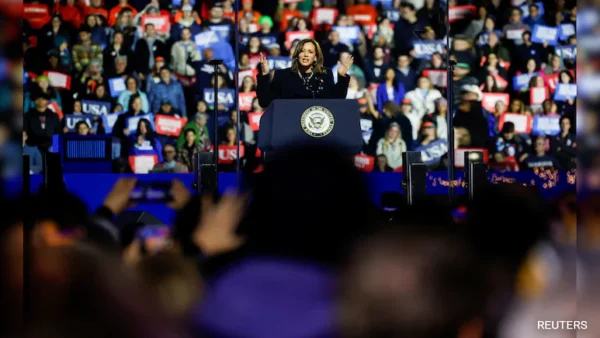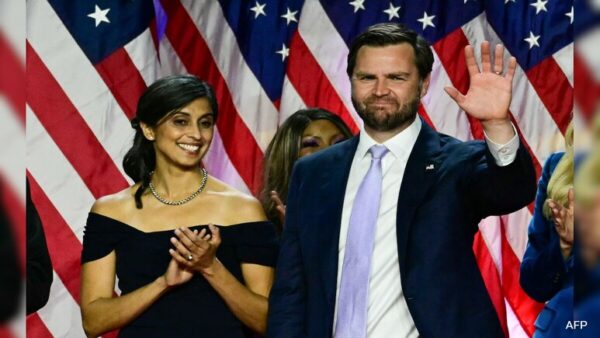World News
Explained: Why Kamala Harris’ historic White House bid failed
After Kamala Harris’ loss in the 2024 presidential election, her tense negotiations with union leaders underscore a key failure of her campaign: connecting with working-class voters worried about the economy and high prices.

In a meeting at the Washington headquarters with one of America’s most powerful unions in September, Vice President Kamala Harris said she would better protect union jobs and workers’ livelihoods than Donald Trump.
But leaders of the International Brotherhood of Teamsters, which has long been strongly aligned with her Democratic Party, did not seem to agree. When Harris argued that her Republican opponent was not a champion of the working class, union bosses questioned her about whether she and President Joe Biden had done enough for union workers, according to a Teamster leader who recalled the September 16 meeting to Reuters. Within days, the union publicly embarrassed Harris by refusing to endorse a Democratic presidential nominee for the first time since 1996.
Ahead of Harris’s loss in the 2024 presidential election, her tense negotiations with union leaders underscore a key failure of her campaign: connecting with working-class voters concerned about the economy and high prices.
After Biden’s dramatic retreat just months before Election Day, Harris put her campaign together as if it were an airplane being built in flight, her advisers told reporters. The 60-year-old former prosecutor and U.S. senator emphasized a case that Trump was a threat to democracy and women’s rights, while promoting a populist economic platform and reproductive freedom.
Her entry turned around a race her party was set to lose. She made history as the first woman of color to top a major party’s ticket. She generated a surge in enthusiasm, broke fundraising records — raising $1 billion in less than three months — and won endorsements from celebrities ranging from pop star Taylor Swift to actor and former California governor Arnold Schwarzenegger.
But Harris’ campaign ultimately failed to address voters’ deep concerns about inflation and immigration — two issues that opinion polls show favor Trump. Her defeat underscores a profound shift in American politics over the past decade as blue-collar voters have become increasingly Republican — a trend that Trump has accelerated.
Harris also struggled to counter another Trump-era trend: a flood of misinformation unprecedented in modern American elections. An avalanche of misrepresentations and falsehoods about his record were unleashed by the former president and amplified on right-wing websites and media, including conspiracy theories on issues ranging from migrant crime to voter fraud.
When asked by Reuters during the election about the misinformation Trump amplified, his campaign officials generally either repeated the falsehoods or did not respond to requests for comment.
As of Wednesday morning, Trump had won 279 electoral votes to Harris’s 223, with votes still to be counted in several states. This account of Harris’s defeat is based on Reuters interviews with Harris campaign staff, White House officials, Democratic Party advisers and close aides.
It was always going to be a tough task. The US has only once elected a president – Barack Obama in 2008 and 2012 – who was not a white man. As the daughter of an Indian mother and Jamaican father, Harris had risen higher in the country’s leadership than any other woman.
The only other woman to get as close as her – Hillary Clinton, who was defeated by Trump in 2016 – had staked her candidacy on becoming the first female president. In the wake of Clinton’s loss, Harris resisted putting her identity at the center of her campaign, close aides and advisers said. Instead, she tried to motivate voters on issues important to women and Black voters in the election — from abortion rights to middle-class tax cuts and housing affordability.
But those messages did not succeed at a time when many voters were aghast at rising consumer prices during the first three years of the Biden administration.
“Despite fairly strong economic growth, particularly after a major global pandemic, most Americans did not feel like they were getting ahead economically,” said Melissa Deckman, a political scientist and chief executive of the Public Religion Research Institute, a nonpartisan research firm. “The Harris campaign did not do a good job of explaining how her policies would help the middle class, or at least the message did not really resonate with many voters.”
According to a preliminary national exit poll conducted by data provider Edison Research, a majority of voters said they trusted Trump more to handle the economy, with 51% saying they did compared to 47% for Harris. And voters who said the economy was their primary concern overwhelmingly voted for Trump than Harris — by a margin of 79% to 20%.
The economy proved to be a bigger concern than reproductive rights among voters, with 31% of voters saying the economy mattered most in deciding how to vote, while 14% cited abortion. The election also showed a stark gender gap. Harris won 54% of female voters nationwide, according to preliminary exit polls, while Trump won 44%.
The Harris and Trump campaigns and the White House did not immediately respond to requests for comment.
“America has given us an unprecedented and powerful mandate,” Trump said Wednesday before a crowd of supporters at the Palm Beach County Convention Center.
Electoral gold
The election was marred by dramatic twists and turns, including two assassination attempts against Trump and Biden’s shock decision to abandon his re-election bid on July 21.
Democrats united behind Harris with astonishing speed and secured her party’s nomination within two weeks, buoyed by her ability to overturn the generational argument over Trump. Two decades older than her, Trump had successfully painted the 81-year-old Biden as a frail and confused old man. Many Democrats hoped she would reverse that.
Some Democratic strategists questioned the wisdom of one of her first big decisions: choosing Minnesota Governor Tim Walz as a running mate over Pennsylvania Governor Josh Shapiro, a skilled orator who has proven a political force in a state that is a must-win. Her campaign hoped that the gun-owning Walz, a liberal policy champion and plain-speaking National Guardsman from the Midwest, would help them win over rural white voters.
Walz had garnered buzz before Harris was chosen, capturing Democratic heart and media attention by calling Trump and his running mate, Ohio Senator J.D. Vance, “weird” on national television in July. Later, however, Walz drew unwanted attention for misstatements of his biography, including his military service, and an uneven debate performance against Vance.
Walz and Vance did not immediately respond to requests for comment.
Still, the Harris campaign believed her key issues — reproductive rights and Trump’s divisiveness — would energize a coalition of women, Black voters, young Americans, independents and “Never Trump” Republicans that would propel her to the White House.
Harris emerged as a spokesperson for abortion rights even before the race began. When the U.S. Supreme Court officially overturned Roe v. Wade in 2022, declaring a constitutional right to abortion no longer existed, the setback for women’s reproductive rights created an unexpected opportunity for Harris.
The decision catapulted her from the political periphery to the center of America’s culture wars. Opinion polls showed that a majority of Americans disapproved of the court’s ruling — and Harris became the face of an issue that Democratic strategists saw as electoral gold.
For the first time in Biden’s presidency, he handed a decisive issue entirely to his vice president. She hit the road and spoke forcefully on a topic that played a big role in saving Democrats from the expected bloodbath in the 2022 congressional elections. After the midterm elections, with Democrats holding on to the Senate and reduced to a slight minority in the House of Representatives, Harris was now seen as a viable future leader in the party.
Still, even after Biden withdrew, concerns remained among some top White House aides about the former San Francisco district attorney’s political skills — including perceptions that she hadn’t made a mark as vice president, that her campaign for the 2020 Democratic nomination was short-lived and that she had limited experience in wooing conservative voters in battleground states. Some also questioned whether she could overcome the long history of racial and gender discrimination in the US.
After securing the nomination, Harris initially shrugged off many of those concerns. She revived a beleaguered Democratic campaign, attracting record-high fundraising and a sizable outpouring of support. She soon overtook Trump in the polls, a sign that she was generating enthusiasm among voters, especially women. Trump had previously been seen as the frontrunner, partly based on his perceived strength on the economy after years of high inflation under Biden.
She aced her first big test — a televised debate against Trump on Sept. 10.
As Harris’s team prepared for her only face-to-face contest with Trump, they focused on ways to embarrass the former president and draw attention to his frequent lies on policy, according to multiple aides involved in the preparations. Aides said Harris holed up in Pittsburgh with advisers and staged a mock debate for the prime-time showdown.
The strategy proved effective. Harris appeared to be unsettling her opponent during the debate. She pressed Trump on the economy, Ukraine, healthcare, the January 2021 Capitol riots, and abortion, leaving him flustered and struggling to respond.
Fundraising boom: Her campaign said she raised $47 million in the 24 hours after the debate. Polls showed most voters thought Harris had won. Trump turned down offers for another debate, claiming she had already beaten him.
During the campaign, Harris mocked Trump’s debate performance, including his comment that he had “concepts of a plan” to replace the federal healthcare law. As she rose in polls, Harris’s campaign believed she was opening up states that were out of Biden’s reach, including North Carolina, where the president lost by the narrowest margin against Trump in 2020 and where she was tied in polls with Trump.
‘This could cost us the election’
North Carolina was the site of her next big test, Hurricane Helene in late September, one of the deadliest hurricanes to hit the U.S. in the past 50 years. The storm shifted focus from messages at the heart of Harris’ campaign to the Biden-Harris administration’s handling of the disaster.
It came at a time when her lead was dwindling. Trump criticized the Democratic administration’s response to the disaster, linking it to his strongest issue, immigration. As the death toll mounted and many areas of North Carolina were devastated, Trump promoted and spread falsehoods, including claims that Harris spent disaster-assistance money on housing illegal immigrants.
In response to a recent Reuters request for comment about false claims about the use of disaster funds, the Trump campaign repeated the allegation that the money was spent on housing immigrants in the country illegally.
Harris halted campaigning and flew to Washington on Sept. 30 for a briefing on Biden’s emergency response. A Reuters reporter saw three staffers on her plane sitting on the floor, ripping up the briefing book and replacing the pages with new notes.
The disaster, which killed more than 200 people, marked a shift in the race, as misinformation about the administration’s response and Trump’s tough rhetoric on immigration took hold. Unfounded claims included that the government hid deaths, seized charitable donations and diverted disaster funds meant to help immigrants. Harris’ campaign struggled to address voters’ concerns about the false claims and a rise in illegal border crossings during Biden’s presidency.
One jurisdiction that illustrated the risks for Harris was Buncombe County, a North Carolina Democratic stronghold of about 280,000 people, which was hit by the storm. Afterward, Democrats stopped targeting potentially persuaded Republican voters because they worried they had become too hostile because of misinformation, Buncombe County Democratic Chair Kathy Cline told Reuters. In the end, Trump won the state.
As the race tightened in October, and polls indicated a toss-up, concern spread among Democratic strategists.
They focused on solidifying the so-called Blue Wall of Democratic states: Michigan, Pennsylvania and Wisconsin. Eight years ago, when Trump defeated Hillary Clinton, he broke the Blue Wall by winning all three states, each by less than one percent. In 2020, Biden won them back. Strategists argued that holding the Blue Wall now was Harris’s best path to the White House. But they had a problem: Michigan and the Gaza war.
Michigan’s large population of Arab Americans and Muslims helped cement Biden’s 2020 win in the state. Trump had angered many of these voters in his first term, partly by banning immigration to the U.S. from several Muslim countries early in his term.
In the final stretch of the race, Muslim and Arab-American voters told Reuters they were disappointed that Harris did not distance herself more from Biden’s unwavering support for Israel during the Gaza war. In the final weeks, Trump aggressively courted their vote. Many said they would stay out of the election or vote Republican.
Harris’ staff knew that disappointed Muslim and Arab-American Democrats were a risk. “It could cost us the election,” a senior Michigan worker for Harris said in July.
The campaign ultimately concluded that winning back those voters completely was impossible. To make up for their losses, campaign officials said they focused in the final weeks on garnering substantial support from union workers and black voters in Detroit, the nation’s largest black-majority city.
Economic threats
But some issues, such as inflation, threatened Harris.
Her campaign hoped the economic recovery from the pandemic would be a winning issue. Growth in the U.S. is clearly stronger than in other major industrialized countries. Stock market indices are close to record highs.
Instead, the issue eroded Democratic support throughout much of 2024 as union workers and non-college-educated white voters turned to Trump, surveys showed. Sharp increases in housing and food costs frustrated voters, overshadowing the strong job market. Trump blamed Harris for the surge during his and Biden’s tenures.
While most unions have long supported Democratic candidates, rank-and-file workers have rallied behind Trump in recent years, which proved to be a decisive factor in his victory. There were some positive signs for Harris. The AFL-CIO, the largest federation of unions, saw a jump in the number of female members supporting Harris and volunteering for her, AFL-CIO President Liz Schuler told Reuters.
In the final weeks of the race, Harris’ momentum had stalled, with polls showing her lead over Trump narrowing. By mid-October, the race was tied in key states.
A clear difference in polling between men and women had also emerged. While Harris narrowed the Republicans’ long-standing lead with white voters by gaining a lead with white women, Trump appeared to increase his lead with men.
Harris changed tactics in an effort to win over more men and Republicans. The campaign sent running mate Walz on a tour in mid-October to reach out to male voters. Harris also held campaign events with former Congresswoman Liz Cheney, one of Trump’s fiercest Republican critics and one of the most prominent conservatives to support the Democrats. A few days later, Trump suggested Cheney should face bullets in battle, sparking outrage among Democrats and pundits.
The vice president also sharpened his attacks on Trump. In a speech presented as her closing argument on Oct. 29, Harris warned about the dangers of Trump becoming another president. He was “unstable” and wanted “unchecked power,” she said at a rally held at the site in Washington where Trump addressed his supporters before they attacked the U.S. Capitol on Jan. 6, 2021. With a well-lit White House behind her, she cast herself as a defender of democracy, unity and freedom.
She also tried to reassure voters about the cost of living. He said Trump’s proposals to raise tariffs would be the equivalent of a “20% national sales tax” on imported goods. He vowed to “protect hard-working Americans who aren’t always seen or heard.” Ultimately, very few of those Americans believed her.



